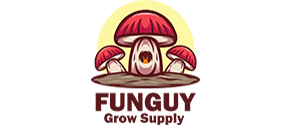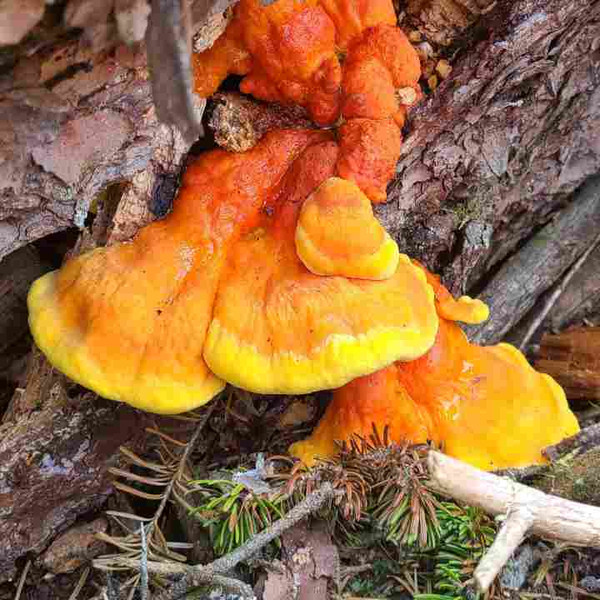Lobster Mushrooms: Discover Maine's Other Lobster & Its Culinary Versatility
Posted by Troy Cosky, Founder FunGuy Grow Supply on 3rd Dec 2023
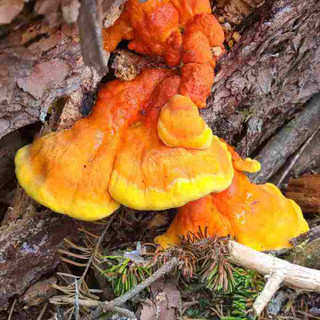
Are you ready to dive into the world of lobster mushrooms? Discover Maine's other lobster, full of culinary versatility. From their vibrant color to their unique taste, these fungi are sure to captivate your taste buds, get everything you need to know through this interesting article.
Whether you're a foraging enthusiast or a seasoned chef, this article will take you on a culinary adventure, exploring the nutritional benefits and various culinary uses of lobster mushrooms. Get ready to indulge in a delightful fusion of flavor and health.
Let's get started!
Key Takeaways
- Lobster mushrooms can also be used in a variety of culinary applications, including sautéing, grilling, and soups.
- They are a versatile substitute for seafood and pair well with ingredients like garlic, herbs, white wine, and butter.
- Lobster mushrooms offer nutritional benefits, including being low in calories and fat, a source of dietary fiber, and containing important minerals.
- Conservation and sustainability efforts are important to ensure the availability of lobster mushrooms for future generations.
Lobster Mushrooms: A Fascinating Fungi Fusion
Explore the fascinating fusion of flavors and textures that lobster mushrooms offer as you delve into their culinary versatility. Lobster mushrooms, with their distinctive appearance and unmistakable flavor, are a delightful addition to any dish. If you're wondering how to cook lobster mushrooms, the possibilities are endless. These mushrooms can be sautéed, grilled, or even used in soups and risottos.
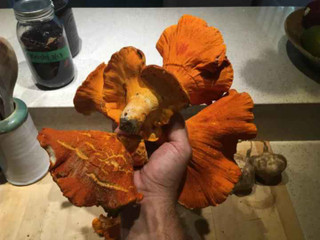
One of the benefits of lobster mushrooms is their ability to absorb flavors. Their firm texture and meaty taste make them an excellent substitute for seafood in dishes like lobster bisque or seafood pasta. Their earthy flavor also pairs well with a variety of ingredients, from garlic and herbs to white wine and butter.
If you're lucky enough to have fresh lobster mushrooms, you can dry them for future use. To dry lobster mushrooms, simply slice them into thin strips and place them in a food dehydrator or an oven set to a low temperature. Dried mushrooms can be rehydrated and used in soups, stews, or stir-fries, adding a concentrated burst of flavor to your dishes.
The culinary versatility of lobster mushrooms knows no bounds. From its ability to absorb flavors to its adaptability in various cooking methods, these mushrooms are a true delight for any chef or home cook. Whether you're a seasoned forager or just starting out, the unique taste and texture of lobster mushrooms are sure to impress. So, let your creativity soar and experiment with this fascinating fungi fusion in your kitchen.
The Culinary Versatility of Lobster Mushrooms
Discover the endless possibilities of incorporating lobster mushrooms into your culinary creations. These versatile fungi can elevate your dishes to new heights with their unique flavor and texture. Here are three ways you can make the most of from cooking with lobster mushrooms:
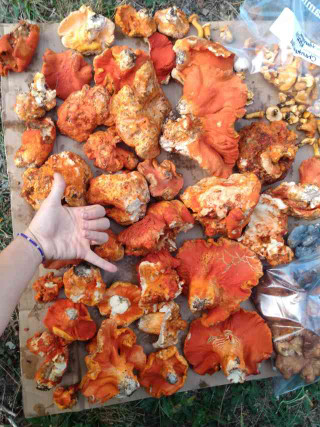
- Wild Mushroom Risotto: Indulge in the comforting flavors of a creamy risotto infused with the earthy essence of lobster mushrooms. The tender and meaty texture of these mushrooms adds a delightful contrast to the creamy rice, creating a dish that is both satisfying and sophisticated.
- Sautéed Delight: For a quick and simple option, sauté fresh sliced lobster mushrooms in butter, white wine, garlic, and herbs. The rich aroma and savory taste of this dish will leave your taste buds craving for more. Serve it alongside grilled fish or as a flavorful topping for a juicy steak.
- Dried Lobster Mushrooms: Don't let the season limit your enjoyment of lobster mushrooms. Dried lobster mushrooms are a fantastic pantry staple that can be rehydrated and used in a variety of dishes, including soups, stews, and sauces. The concentrated flavor of dried mushrooms adds depth and complexity to your culinary creations.
With these culinary ideas, you can explore the diverse flavors and textures of lobster mushrooms to create memorable meals. Now that you have discovered the culinary versatility of lobster mushrooms, it's time to embark on a foraging and cooking adventure.
Harvesting Lobster Mushrooms: A Thrilling Endeavor
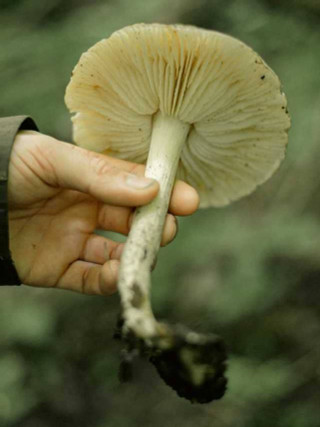
Harvesting lobster mushrooms is a thrilling endeavor for mushroom enthusiasts and foragers. These vibrant fungi, often found in the wild, are a sight to behold with their striking reddish-orange exterior. When it comes to harvesting lobster mushrooms, it's essential to exercise caution and care. The first step is correctly identifying them, ensuring they have the characteristic features of this unique species. Once identified, gently remove them from the forest floor, being careful not to damage the delicate mycelium network they share with their host mushrooms. A knife or small digging tool can be handy for cleanly cutting the stem at the base. As you gather these culinary treasures, remember to leave some behind, allowing the mushroom population to thrive and ensuring the ecosystem remains intact for future foragers. Lobster mushrooms offer a delightful culinary experience, and the thrill of finding them in their natural habitat adds an extra layer of enjoyment to the process.
Foraging and Cooking Experiences: A Culinary Adventure
Ready to embark on a culinary adventure? Get ready to sauté your way to mushroom bliss with these lobster mushrooms. With their vibrant color and delicate flavor, they are the perfect addition to any dish. So grab your pan, heat up some oil, and let the foraging and cooking experience begin.
Sautéed Lobster Mushrooms:
Get ready for a culinary adventure as you sauté lobster mushrooms, immersing yourself in the foraging and cooking experience. The earthy aroma of mushrooms mingling with fragrant garlic and aromatic herbs will transport you to a world of flavors. Here are three reasons why sautéed lobster mushrooms are a must-try:
- Bursting with flavor: Lobster mushrooms have a rich and meaty taste that pairs perfectly with the buttery, garlicky goodness of sautéing. Each bite is a delightful explosion of flavors, leaving you craving for more.
- Versatile and adaptable: Sautéed lobster mushrooms can be enjoyed on their own as a flavorful side dish or incorporated into various lobster mushroom recipes. From pasta dishes to risottos and even grilled seafood, these mushrooms add depth and complexity to any dish.
- A connection to nature: Foraging and cooking lobster mushrooms allow you to connect with the natural world and appreciate its bountiful offerings. It's a chance to explore the woods, discover edible treasures, and create memorable culinary experiences.
Nutritional Benefits and Culinary Uses: A Delightful Fusion of Flavor and Health
To fully appreciate the culinary versatility of lobster mushrooms, it's important to understand their impressive nutritional benefits and the creative ways they can be used in cooking. These vibrant fungi not only tantalize our taste buds but also offer a range of health advantages. With a low calorie and fat content, lobster mushrooms are great option for those who prioritize their health. They are also a reliable source of dietary fiber, actively supporting digestion and a healthy gut. But it doesn't stop there. Eating lobster mushrooms can also boast remarkable levels of vital minerals such as potassium, copper, and selenium, which actively aid diverse physiological processes, promoting cardiovascular well-being and fortifying the immune system.
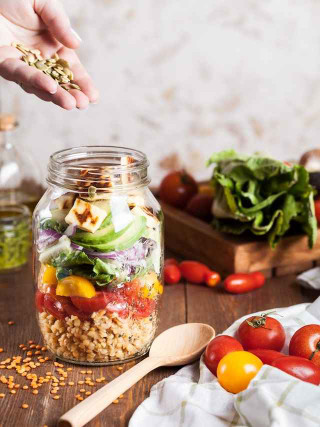
But the benefits of lobster mushrooms go beyond their nutritional value. For those seeking a vegetarian or vegan option, lobster mushrooms offer an excellent substitute for seafood. Their meaty texture and robust flavor make them a delightful addition to dishes like mushroom risottos, where they can be incorporated alongside other wild varieties. Penny Bun and Cantharellus Cibarius mushrooms, when combined with lobster mushrooms, create a luxurious and comforting experience that will leave you craving for more.
Now that you've discovered the delightful fusion of flavor and health that lobster mushrooms bring to the table, it's time to explore the next chapter: conservation and sustainability. By nurturing the future of lobster mushrooms, we can ensure their availability and continue to enjoy their culinary versatility for generations to come.
Conservation and Sustainability: Nurturing the Future of Lobster Mushrooms
To ensure the future of these mushrooms, you must prioritize their conservation and sustainability. Here are three essential steps you can take to nurture the longevity of these remarkable fungi:
- Familiarize yourself with regulations: Before heading out to forage lobster mushrooms, it is crucial to understand the regulations and guidelines governing mushroom collection in your region. Many areas have restrictions in place to protect the populations of wild mushrooms, including lobster mushrooms. By adhering to these regulations, you contribute to the preservation of these fungi and maintain the delicate balance of our ecosystems.
- Practice selective harvesting: When foraging these mushrooms, it is essential to practice selective harvesting. This means collecting only mature specimens while leaving the young ones undisturbed. By allowing the young mushrooms to grow and release spores, you contribute to the regeneration of their population, ensuring their continued existence in our natural habitats.
- Support local farmers and cultivators: Another way to promote the sustainability of these mushrooms is by sourcing them from local farmers or mushroom cultivators. These dedicated individuals cultivate lobster mushrooms in controlled environments, ensuring a more sustainable supply while minimizing the impact on wild populations. By supporting these farmers, you contribute to the long-term sustainability of lobster mushrooms and help preserve their place in our culinary and natural heritage.
The Delightful Convenience of Dried Lobster Mushrooms
As you continue exploring the allure and versatility of lobster mushrooms, delve into the delightful convenience of dried mushroom options that offer year-round culinary possibilities. While fresh lobster mushrooms are a treat, having dried lobster mushrooms on hand ensures you can enjoy their unique flavors anytime. The drying process intensifies the umami-rich characteristics of these mushrooms, creating an earthy and seafood-like taste that can elevate a variety of dishes. With a long shelf life, dried lobster mushrooms are an excellent pantry staple for mushroom enthusiasts.

The texture of rehydrated dried lobster mushrooms adds a delightful chewiness to your dishes, giving you a satisfying mouthfeel with every bite. To find dried lobster mushrooms, check out local specialty food stores, farmers' markets, or reputable online suppliers that specialize in wild mushrooms. These sources often provide high-quality dried lobster mushrooms that capture the essence of their fresh counterparts.
As compared to other mushrooms, using dried lobster mushrooms is simple. Just rehydrate them in warm water or broth until they regain their plumpness and tender texture. The flavorful soaking liquid, infused with the essence of the mushrooms, is a prized addition to sauces, soups, and stews, enhancing their richness and complexity.
Whether you stumble upon fresh lobster mushrooms during foraging adventures or choose the convenience of dried options, the allure of these fungi remains undeniable. Their unique flavor profile and versatility in culinary applications make them a treasure worth exploring, celebrating, and savoring year-round. So, stock up on dried lobster mushrooms and unlock their delightful convenience in your kitchen.
Conclusion
Now that you've explored the versatility of lobster mushrooms, it's time to reflect on their culinary significance and the broader lessons they teach us about our connection to the natural world. Here are three key takeaways from our journey:
- Nature's Creativity: The transformation of lobster mushrooms, from potentially harmful to delectably edible, showcases the remarkable creativity of the natural world. It reminds us that even in the face of challenges, nature has the ability to adapt and thrive.
- Sustainable Foraging: By practicing sustainable foraging, we can enjoy the culinary and nutritional benefits of lobster mushrooms while also preserving their existence and the health of the ecosystems they inhabit. This approach highlights our interconnectedness with the natural world and our responsibility to protect it.
- Interconnectivity of Life: Lobster mushrooms serve as a symbol of the interconnectedness of all life. From the symbiotic relationship between the mushroom and the host tree to the intricate web of ecological interactions in the forest, our exploration has revealed the complex and delicate balance of nature.
As we conclude our journey with lobster mushrooms, we must remember that this is just one chapter in the grand saga of the natural world. There is still so much more to uncover and learn. So, let us continue to explore, appreciate, and protect the wonders that nature has to offer. Together, we can forge a deeper connection with the natural world and ensure its preservation for future generations.
Grow Lobster Mushrooms Today!
Are you inspired by the magical world of lobster mushrooms and ready to embark on your own fungi cultivation journey? Visit FunGuy Grow Supply, your ultimate destination for all things related to mushroom growth. Explore top-quality mushroom grow kits and start your fungal adventure today.
Frequently Asked Questions
How Do Lobster Mushrooms Get Their Name?
Lobster mushrooms get their name from their vibrant red color, which resembles that of a cooked lobster. These mushrooms are not actually a type of lobster, but they are named so because of their appearance. They are a unique and versatile ingredient that can be used in various culinary dishes.
Are Lobster Mushrooms Safe to Eat?
Yes, lobster mushrooms are safe to eat. They may not look like your typical mushroom, but they are perfectly edible and have a unique flavor that many people enjoy. When cooked, lobster mushrooms have a meaty texture and a taste similar to seafood, hence the name. They are often used in various dishes, such as soups, stews, and stir-fries, adding a delicious twist to your culinary creations. So go ahead and give them a try!
Can Lobster Mushrooms Be Found in Other Parts of the World Besides Maine?
Yes, lobster mushrooms can be found in other parts of the world besides Maine. They are known to grow in various regions across North America, including the Pacific Northwest and the Rocky Mountains. Additionally, they have been found in parts of Europe and Asia. So, if you're interested in trying lobster mushrooms, you might be able to find them in other places too!
What Are Some Common Recipes or Dishes That Use Lobster Mushrooms?
There are many delicious recipes and dishes that use lobster mushrooms. You can try sautéing them with garlic and butter to bring out their rich flavor, or adding them to pasta dishes for a unique twist. Lobster mushrooms also work well in soups and stews, providing a meaty and earthy taste. Another popular option is to use them as a substitute for lobster in seafood recipes. The culinary versatility of lobster mushrooms is truly impressive!
Are There Any Known Health Benefits or Medicinal Properties Associated With Lobster Mushrooms?
Are there any known health benefits or medicinal properties associated with lobster mushrooms? Well, when it comes to lobster mushrooms, there isn't much scientific evidence supporting any specific health benefits or medicinal properties. However, they are a good source of nutrients like vitamin C, potassium, and fiber, which are all important for a healthy diet. So while they may not have any unique healing properties, incorporating lobster mushrooms into your meals can still provide you with some nutritional benefits.
Where can I find lobster mushrooms?
Lobster mushrooms, known for their bright orange-red color, can be found at local farmers' markets, fancy food stores, and online shops. If you're experienced, you might spot them in the wild. But if you're not sure, it's safer to buy them from a reliable source. Enjoy exploring and cooking with these unique mushrooms!
Reference:
- Spahr, D. L. (2018). Edible and Medicinal Mushrooms of New England and Eastern Canada: A Photographic Guidebook to Finding and Using Key Species. North Atlantic Books.
- Laperriere, G., Desgagné-Penix, I., & Germain, H. (2018). DNA distribution pattern and metabolite profile of wild edible lobster mushroom (Hypomyces lactifluorum/Russula brevipes). Genome, 61(5), 329-336. https://doi.org/10.1139/gen-2017-0168.
